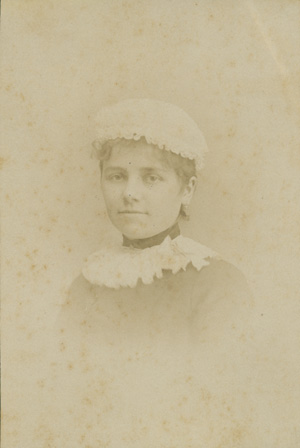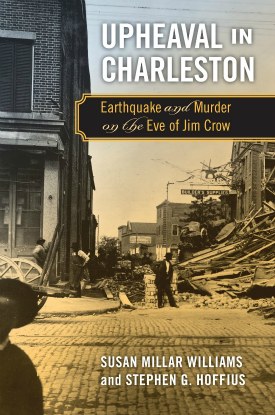As part of our “RBMSCL Scholars” series, we’ve asked some of the wonderful researchers that the RBMSCL has hosted over the years to contribute a few words on their new books and research projects. Today, on the 125th anniversary of the Charleston Earthquake of 1886, we present an essay by Susan Millar Williams and Stephen G. Hoffius, authors of Upheaval in Charleston: Earthquake and Murder on the Eve of Jim Crow, released in June by The University of Georgia Press.
 A chubby-cheeked young woman in a ruffled cap gazed up at us from a sepia photograph labeled “Dawson’s French Maid.” There she was, the unlikely femme fatale who had triggered one of Charleston’s most notorious murders. We had been looking for such a photo for eight years.
A chubby-cheeked young woman in a ruffled cap gazed up at us from a sepia photograph labeled “Dawson’s French Maid.” There she was, the unlikely femme fatale who had triggered one of Charleston’s most notorious murders. We had been looking for such a photo for eight years.
The collection we were exploring, the Francis Warrington Dawson Family Papers, is a vast compendium best known for the six-volume diary kept by the precocious teenager Sarah Morgan, later Dawson’s wife, during the Civil War. But it also contains material that is crucial to understanding, among many other topics, the great Charleston earthquake of 1886, the political struggles of late nineteenth-century South Carolina, and the murder of Francis Dawson, editor of the Charleston News and Courier.
Frank Dawson is the central figure in our book, Upheaval in Charleston: Earthquake and Murder on the Eve of Jim Crow. After the earthquake, Dawson shaped public opinion around the country, rallied his fellow citizens to try to rebuild their city, received a major portion of the relief money that was sent, and spoke loudest at meetings of the Executive Relief Committee. Because Sarah was traveling in Europe with their two children when the earthquake hit, the couple wrote each other daily. Sarah’s letters did not survive, but she carefully preserved Frank’s, in which he updated her on earthquake damage and his fears about the changes that were happening in Charleston. “Had you been here,” he wrote to his nervous wife, “you would have been dead, or in a lunatic asylum.”
 Hailed as a hero in the aftermath of the earthquake, Dawson was denounced by white supremacists and murdered on March 12, 1889, less than three years after the disaster. Sarah went to her grave convinced that her husband was the victim of a political conspiracy.
Hailed as a hero in the aftermath of the earthquake, Dawson was denounced by white supremacists and murdered on March 12, 1889, less than three years after the disaster. Sarah went to her grave convinced that her husband was the victim of a political conspiracy.
In fact, Dr. Thomas B. McDow shot Frank Dawson when the editor forbade him to talk to Hélène Burdayron, a voluptuous young Swiss woman who was taking care of the Dawson children. During McDow’s trial for murder, the world came to know Burdayron as “the French maid.” The photograph we discovered at Duke is the only known image of her.
In the 1940s, a graduate student named Frank Logan, who was writing his master’s thesis on Dawson, contacted the Dawsons’ son Warrington, who lived in Versailles. For several years he typed out lists of questions, and Warrington sent back long answers, sometimes slightly hysterical, but always packed full of telling personal detail. Did Frank Dawson prefer dogs or cats? How many cigars did he smoke a day? How did Hélène behave while living with the Dawson family after Frank’s death? Good graduate student that he was, Frank Logan passed over most of these homely tidbits and in his thesis he focused on Dawson’s role in some of the bloodiest and most terrifying episodes in southern history.
Luckily for us, Logan went on to serve on the Duke faculty, and he convinced Warrington to donate his mother and father’s papers to the RBMSCL, along with his own. Among them are scores of photographs, Sarah’s diaries and scrapbooks, family letters, and business correspondence. Together they reveal a rich tapestry of political and domestic life, including that amazing photo of the mousy-looking woman who possessed “a bust fit for a Venus” and enough sexual magnetism to provoke Charleston’s crime of the century.
Find out more about the book at www.upheavalincharleston.com!

